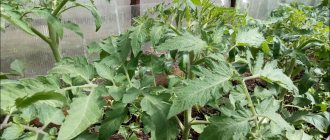Hello, dear readers! Today we will talk about the need to tie up tomatoes. You probably already know that this is a very important stage in growing tomatoes, since our bushes do not rot, they are easier to care for, they look neat, I will tell you about the benefits of garter a little further. I recommend reading the article to the end, everything I write about here is very important!
Be sure to read articles about growing tomatoes in general, as well as individual articles about open ground, greenhouses, and balconies. I also wrote an article about the best tomatoes and their varieties, which I also recommend reading.
Here we go?)))
Why tie up tomatoes?
Three main reasons:
- To save the plant. Without a garter it is quite difficult to maintain the integrity of the bush. Some varieties reach a height of more than 2 meters. As a result, they fall and break under their own weight. Low-growing bushes have a lower risk of fracture, but when not tied up, they drop their fruits to the ground. On the ground, tomatoes receive less light and air, and are often attacked by insect pests and rot.
- To improve the quality of the harvest. Gartering tomatoes allows you to get a better harvest. Straight, straightened, vertically positioned bushes literally bathe in sunlight and are well ventilated. They grow better, and the fruits are larger in size, bright in color and have excellent taste.
- To make caring for the plant easier. Bushes tied to a support are more convenient for watering, hilling, weeding, spraying, and pinching. In addition, the effectiveness of the procedures in this case will be significantly higher.
The result is healthy plants and a rich, high-quality harvest.
Who first came up with the idea of tying the bushes to a support - history is silent.
Probably, our ancestors, when they began to massively grow the strange berry imported from Peru, noticed that the capricious crop tied to pegs gives an excellent harvest and does not rot on the vine.
In the most productive years for tomatoes, when the bushes break under the weight of ripe fruits, there is nothing left to do but tie the stems, fixing the heavy side shoots.
Of course, there are gardeners for whom this is extra labor and they even manage to get good results. They are either lucky, or they water the seedlings against diseases with chemicals.
The goal of a real gardener is to grow a natural product that cannot be bought on the market. Its own, environmentally friendly.
So, gartering tomatoes is recommended to:
- relieve branches and stems from the weight of fruits and prevent branches from breaking off;
- protect plants from late blight by ensuring good ventilation between the bushes and preventing the lower leaves from rotting;
- let the sun shine evenly on the entire bush so that the tomatoes ripen quickly and amicably;
- provide convenient access to each bush for treating it from pests and harvesting;
- properly water the bushes at the roots and hill up the beds;
- simplify care - pinching, breaking off lower leaves, loosening the soil at the root.
So it’s worth devoting a few hours of country life to tying up the bushes in the tomato beds.
Garter - mandatory or desirable?
Both theorists and agricultural practitioners agree that gartering tomatoes is not just a “recommended” action, it must be present in growing the plant.
How to tie up tomatoes
This relatively simple procedure leads to the following positive consequences for the plant, and, as a result, the harvest:
- The garter guarantees the safety and integrity of the plant stem. It will not break or bend as the green mass grows. Consequently, the plant will not have to spend its resources on strengthening it - everything will go into harvest
- The leaves of a tomato bush properly tied in a vertical plane are located in such a way that sunlight will affect them with maximum efficiency. In addition, the free space between the leaves will provide the plant with an influx of fresh air. Thanks to this, the supply of carbohydrates to the plant will be sufficient to form a normal harvest.
- Precipitation and weather changes will not cause significant damage to a tied tomato bush located in open ground. The support will prevent the branches of the plant from breaking if they are not too strong.
- The garter greatly simplifies the watering procedure, since the tomato must be watered exclusively at the root . He does not like moisture on the leaves. If the branches are tied, the risk of such situations is reduced to almost zero
- Tied tomatoes are much more convenient to spray; in addition, most of the processing liquid will remain on the leaves and will not go into the ground. Consequently, the plant will be much less susceptible to the influence of fungal and viral diseases, as well as pests
- Convenience of work applies not only to spraying, but also to all other plant care procedures. Mulching, weeding, pinching, etc. - all this is much more convenient to do with a neatly tied bush, when the tomato foliage does not interfere with the process
- During the formation of fruits, they will not only be easily accessible during harvesting on a tied bush , but will also be more distant from the surface, which will automatically protect them from pests such as rodents or slugs
- In addition, the fruits “raised” by the garter above the surface will not have physical contact with it. Thus, the constant moisture of the top layer of soil will not provoke rotting of the vegetable
An easy way to tie a garter using a plastic bottle
Even if half of the listed advantages are realized, this alone is enough to start tying up the bush.
Rules for gartering tomatoes
How to properly tie tomatoes? This process should be approached responsibly. The recommendations have been developed through years of experience as amateur gardeners and scientific works of vegetable growers. You shouldn’t ignore the advice, and there’s no need to reinvent the wheel when everything is clearly and clearly formulated - how to tie up tomatoes correctly and in a timely manner.
If you take a closer look at the experience of large agricultural enterprises that are engaged in greenhouse cultivation of tomatoes. They have each plant tied to a trellis. Workers make sure that not a single branch breaks. The harvest and, of course, income depend on this.
For an ordinary summer resident, the main thing is not money - but the value of his work and a good harvest of delicious tomatoes for his beloved family.
The rules for gartering are not that complicated, it’s worth remembering them:
- The key to getting a good result will be timely tying up the bushes. In greenhouses, seedlings are tied to a support a week after planting. As it grows, the stem is wrapped around a cord.
- Before gartering, the first pinching of bushes is carried out.
- Ground tomatoes begin to be tied up when the bushes grow so large that an ovary forms on them and they can break from gusts of wind.
- Before installing the supports, the soil needs to be watered. Wet soil will seal the holes and will not crack after drying. If this rule cannot be neglected, dry soil will damage the roots.
- The central stem of the tomato is tied first, and after the fruits have formed, the branches are fixed, which may break off under the weight of the fruit.
- The stem must not be pinched. The garter is done freely.
- To prevent next year's crop from transmitting diseases, old garter material is removed from the area and disposed of.
- Tall bushes are first attached under the lower brush, then higher.
- It is enough to secure low-growing tomatoes in the middle of the main stem.
- Between the bush and the support, free space is left for the plant to grow.
There are only 10 rules that cannot be ignored. With this method of growing, plants get sick less and the yield is higher.
Benefits of a Garter
It is better to tie up even low-growing varieties of tomatoes - the fruits, if they are quite large, or the fruits in the cluster, under their weight in a ripe state, gradually bend to the ground and lie on it. But the ground under the bushes needs to be watered regularly when there is no rain for a long time, and if the rains are frequent, the soil may be excessively waterlogged. Due to excess moisture, tomato fruits are more often affected by late blight, blackleg, and begin to rot. And the ripening will be uneven - the side of the tomato facing the sun will sing, but its other side, lying on the ground, will remain unripe and may begin to turn black and rot.
- the garter makes watering easier - the bushes do not like moisture getting on them;
- makes maintenance easier - it’s convenient to quickly and accurately loosen the soil and apply fertilizers;
- Provides ventilation and drying of bushes after heavy rains;
- uniform sunlight ensures uniform and rapid ripening of fruits;
- the bushes will not break from strong winds or bend;
- they are easier to spray, so they will hurt less;
- it is convenient and easy to process fixed tomatoes - hilling, mulching, weeding, pinching;
- mice, slugs and other pests will not be able to damage tomato bushes and fruits.
Deadlines
The main task of tying up tomatoes is to ensure normal air circulation in the garden bed, access to each bush, and so that the branches do not break. The bush cannot be allowed to overgrow in order to form an even main stem in time.
The bushes are tied to a support when they begin to bend. At this time, the stem reaches the desired thickness and height. The bush has already formed up to 10 true leaves. A strong bush is no longer a tender seedling that can be easily damaged when staking.
Tomatoes can be divided into three varietal groups - early-ripening, mid-ripening and late-ripening tomatoes. The tying time for each variety after planting seedlings in the ground or under film is as follows:
- early varieties - from 35 to 40 days;
- mid-ripening varieties - at 50-60 days;
- late varieties - at 70-80 days.
The garter period depends on the growing region, soil quality, fertilizing and other factors affecting plant growth. Over time, experience is gained and the gardener himself is able to determine a convenient time.
Garter accessories
Three questions need to be considered here: how and where to tie the tomatoes, what tools will be needed. Perhaps some gardeners will already at this stage reconsider the method of attaching the bushes.
Garter material
You can use long strips of fabric, thick twine, twine, and nylon tights. No fishing line or thin wire. The ideal material is elastic synthetic strips of such thickness that light pressure does not injure the stem, and at the same time it is comfortable to work with.
It is often advised not to use cotton fabric for tying tomatoes, as it can begin to rot if it gets wet during rains and watering. But gardeners often, in order to save money, use just such material, obtained from clothing that is no longer suitable for wear.
The cut strips can be soaked in a solution containing copper and then dried. This will not only protect the cotton from rotting for the season, but will also serve as additional protection against late blight and other diseases.
There are special clips and clothespins on sale that can last for years. But, given that several pieces are needed for each bush, using them on large farms is unprofitable and troublesome. It is easier to secure the rope once and then simply wrap the stem around it.
Supports
Metal or plastic pipes, fittings, wooden and iron stakes are used as supports. You can use thick, straight branches freed from side shoots that remain after pruning the garden.
Dry wood is treated with special anti-rotting agents, but only those that cannot harm the tomatoes. They can be soaked in a solution of a copper-containing preparation - this will be enough for a season, and harmful microorganisms will not be able to settle on the support.
Some gardeners wrap metal pegs in direct contact with the tomatoes with agrofibre or cloth soaked in copper sulfate. This serves as additional protection against diseases and prevents contact with a hot surface under the sun.
Meshes are sometimes used as support. But even if you choose one made of durable plastic, it may break in the middle of the season. And at this time, the tied tomatoes are already loaded with fruits. In order not to be left without a harvest, it is better not to take risks and use only chain-link mesh.
When constructing exotic structures for tomatoes, such as wigwams or pyramids, flexible rods, wire and other available materials are used. But they are no better than the usual supports, and serve more to entertain the owners than tomato garters.
Tools
You need sharp, comfortable scissors that can easily cut bandages. You will need a shovel to dig in the pegs.
Some methods of tying tomatoes require the manufacture of a special device for tucking the sling into the ground. You can take a strong rod with a flattened end. But it’s better to flatten one edge of the thick soft wire and make a small notch in it, and bend the other so that it’s comfortable to hold.
Garter material
The choice of material for a garter must be approached with all responsibility. It is important to know what and how to tie tomatoes. The garter should not cut the delicate surface of the stem and branches, accumulate moisture and rot. It should be convenient to make knots without fear that the twine or strip of fabric will tear. The garter material is prepared for one season, and after harvesting it is destroyed to exclude the possibility of transferring the infection to the next year.
It is prohibited to tie up tomato bushes:
- wire;
- thin twine;
- fishing line.
It is better to prepare strips of synthetic fabric up to 5 cm wide and quite long. This can be a nylon utility cord, ordinary twine, or nylon stockings cut into strips.
Tomato garter clips make the job much easier. They come in wood or plastic, are very inexpensive, and are sold individually and in sets. The clip wraps around the stem and snaps into place without pinching it.
When tying with improvised material - strips of fabric or soft ties, you only need ordinary scissors.
And if you have garden tapeners, there is no need for either scissors or material for gartering.
A tapener is a simple device into which adhesive tape is inserted, capturing the stem of the plant along with a peg, mesh cell, and wire. Designed to simplify and speed up gartering. It works on the principle of a stapler, but looks like a garden pruner. A soft ribbon is tucked into the device and carefully bends around the stem. It is very convenient to use, and with a trellis-type garter, when the tomatoes are tall, this is an indispensable tool.
The handles are comfortable, the hand does not get tired. In any online gardening store you can buy a tapener with a set of tapes, staples, a spare knife and a replacement screw. This tool is also useful for tying grapes, cucumbers, and other tall crops.
General garter rules
It is very important to choose the right material for tying tomato bushes. To prevent the garter material from cutting into the stems of bushes, it is better to avoid thin wires, ropes, and fishing line. Last year's material from the fabrics with which the bushes were tied up should also not be used, so that the pest larvae and causative agents of all kinds of infections and bacteria preserved in it do not damage the current crop.
Natural fabrics are not suitable for tying - they can rot and become a haven for various pathogens, bacteria, and insect pests.
It is very good to use various synthetic materials: nylon cords, ropes, twines. We must remember that they must be thick and wide. You can also use garter materials for grapes, old tights, and nylon knee socks. Any material for a garter is only suitable for one season; other garters need to be prepared for the next one.
Nylon cords
Twines
Before tying, the material must be disinfected - washed, steamed or boiled.
With any garter method, no garter material should cut into the tomato stem. Therefore, you need to tie it up, leaving a small gap between the stem and the peg, taking into account that the bush will still grow.
During the season, bushes are usually tied up 2-4 times (depending on the tallness of the variety).
Garter of tomatoes in a greenhouse
When tomato seedlings are grown in a greenhouse in a limited area, special attention is paid to the garter, because greenhouse varieties are usually tall. For example, a specially bred variety for growing in a greenhouse is “Eagle Heart”. The weight of one tomato reaches 800-900 g, and the height of the stem is 170 cm. How can such a giant be left without a garter?
And even the shortest greenhouse cherry tomatoes grow up to 90 cm. If you don’t know when and how to tie up tomatoes, branches with numerous fruits can break off.
Tomatoes in greenhouses are tied up for:
- harvest preservation;
- friendly maturation;
- ensuring watering strictly to the root;
- ventilation of beds;
- convenience of courtship;
- protection from diseases and pests.
Lattice for garter
You will need a couple of buried grates. They should be tilted in different directions from each other. The tomatoes growing between them will themselves support the cunning structure.
Select the height of each trellis taking into account the maximum height of the tomato bushes. You won’t have to tie up a single tomato bush. The tomatoes themselves will choose a convenient place on the trellis holder.
How to tie tall tomatoes
Tall varieties are not intended for regular cultivation. Only on supports. The peculiarity of the garter is the reliable fixation of the stem and side branches. Moreover, the operation should be done so as not to pinch the fragile stems, otherwise the plant will die, and the tomato trusses will remain green.
To understand how important it is to properly tie up tomatoes, it is worth remembering: that thanks to this technique, caring for the crop is much more convenient, and harvesting is much faster.
Rays of light penetrating through polycarbonate or glass are not lost in the thickets of plants, but evenly illuminate each bush, and this contributes to the smooth ripening of fruits.
All the fruits are visible; it is much more difficult to miss already ripe fruits.
Watch the video
How to tie up tomatoes?
Tomatoes are one of the most demanding and capricious garden crops. Getting a good harvest of tomatoes in the Russian climate (with the exception, of course, of the southern regions) is a very difficult matter. An experienced gardener uses a lot of tricks when growing tomatoes - these are special fertilizers, special rules for planting in the ground, organizing watering according to a strictly defined schedule and, of course, garter.
Let's figure out how to tie tomatoes correctly and why do it at all.
Tying options
To secure tomato stems over the beds, several methods of tying tall tomatoes are used:
- Pegs - a high rail is driven in at a distance of at least 10 cm from the bush, a rope or strip of fabric is tied with a loose knot to the peg, wrapping around the stem. As it grows, it makes a few more bindings.
- A simple design for greenhouses consists of supports on which a block is attached. Instead of a block, you can stretch a wire with a cross-section of 3-4 mm so that there is no sagging. A long string is tied to the top bar or wire and goes down to the bush. It is secured with a loop at the base of the stem. As the bush grows, it wraps itself around the twine.
- Wire hooks - synthetic twine is tied onto a cable stretched along the bed. Loops are made on the twine along its length at a distance of 25 cm, wire hooks are threaded through them and the twine is tied to the lower cable. Rubber loops are used for garters. They are wrapped around the stem and the two ends of the elastic are put on a hook.
Tying to a separate support or to stakes
In small country greenhouses it is not possible to build a bulky structure in order to tie up a couple of dozen tomato bushes. For such conditions, the method of tying tomato bushes to a separate support is used. In other words - a regular garter to pegs.
This method is suitable for compact tall and medium-growing varieties. Metal or plastic pipes, tall wooden stakes, and rods are used as support. They should be a couple of tens of centimeters higher than the bush, but in such a way as not to damage the roof of the mini greenhouse. The stems are tied using strips of synthetic fabric or a special tying machine.
One of the easiest ways to tie a garter is with stakes. All that is required are pegs for tying tomato bushes and twine. This method is suitable for medium-sized and short varieties of tomatoes. One peg is used per bush. The stem is grabbed in the middle and a couple more times as it grows. Compact bushes do not branch much and the side branches do not require separate support.
The height of the peg is calculated in this way - 20-25 cm will be used for digging into the ground, 25-30 cm for the height above the bushes. That is, when sawing the material, you need to know what the expected height of the tomatoes is.
A tall bush is rarely tied to stakes; after all, the 2-2.5 m height and plus the load of the bush with fruits makes such a structure too unreliable. For these types of tomatoes there are other methods of gartering.
In addition to wood, metal rods and plastic are used for pegs. Craftsmen prepare stakes themselves from scrap materials, but you can save time and buy ready-made products in the store.
The pegs are installed when the seedlings have grown and the bush is ready to bend. The support is stuck into the ground 10-15 cm before the stem and tied loosely.
After harvesting, the material is pulled out of the ground, thoroughly cleared of soil and stored in a place so that pathogens freeze out in winter.
What to make pegs for gartering tomatoes from
Pegs for gartering tomatoes
Usually stakes for low-grade tomatoes are made from sawn wooden blocks. The thickness can be any, but take into account that the support must hold the plant in an upright position in any weather.
Material suitable for pegs:
- Tree. Smooth tree branches are cut out and the bark is removed from them. The branches are sawn into stakes of the required length. Cheap and accessible.
- Wooden slats, old picket fence. If you plan to use such pegs for several years, it is recommended to burn the bottom edge at a fire to protect the wood from rotting.
- Metal – fittings, pipes, metal profiles, corners. Since metal is expensive and rusts, there is no point in buying fittings. It’s another matter if it remains after construction work.
- Fiberglass is an alloy of metal and plastic. The material looks aesthetically pleasing, does not rot, does not rust, and has sufficient strength. The diameter of fiberglass pegs is recommended to be at least 8-10 mm. For stakes, a fiberglass rod with a diameter of 8-9 mm, reminiscent of metal reinforcement, twisted into a coil is also used.
- As an option: ready-made plastic stakes are sold in construction and gardening stores. A metal rod is inserted inside such a peg for strength. The stakes do not rot and do not corrode.
On a wire frame
An interesting method of gartering, cost-effective only for small plantings of tomatoes. To implement this method, you need to buy a roll of coarse mesh and cut it into pieces in order to make frames.
A wide pipe is installed above a grown bush. As they grow, the stems and branches with tomatoes are attached to the mesh cells. This method has a clear disadvantage - high cost and inconvenience during harvesting.
Dome
If there are only a few tall tomato bushes growing on the site, you can make a so-called dome to tie them up. This is the fastest way to install a support. Around the growing bush, three supports are buried in the ground. They are connected at the top. This results in a stable structure. The tripod is braided from top to bottom with rope or wire.
Such devices are installed with the planting of seedlings. Two or three bushes are planted around the domes at once. You need to make sure that the branches do not grow inside the stakes, since the tomatoes will be inconvenient to tie up.
It is easier to use stakes as supports. They are lightweight and easy to work with. For the dome, you can buy plastic or metal stakes. Ready-made prefabricated domes are ordered in gardening stores and online.
Vertical trellis
Gartering a tomato using a trellis is a simple method. In the garden bed where it is planned to grow tomatoes, a stationary structure is installed:
- supports are driven in along the bed on both sides;
- the ropes are stretched and secured at the same distance from each other;
- seedlings are tied to ropes.
A stationary trellis for open ground is made from pipes or bars dug into the ground. The distance between the posts should be no more than 2 m, and the digging depth depends on the soil. For example, on clay soils the supports go 60 cm into the ground, and in sandy soils 1 m or deeper. Together with a stretched mesh or cord, the structure must support the weight of the crop.
Linear mount
This is an economical and easy to implement option:
- in the greenhouse, loops are attached to the ceiling or a cable is pulled;
- a long twine or rope is attached to the cable;
- the rope is fixed near the bush into the ground;
- the stem grows and wraps around a rope, which acts as a kind of rod, holding the trunk. For reliability, the stem is additionally secured with clips or garters.
Mesh mount
A method that gardeners love. Has a clear advantage over others. The garter system is made like this - a large-mesh dense plastic mesh or aluminum chain-link mesh is fixed between the supports, which are dug in along the bed. Seedlings are planted along it. As the bush grows, all that remains is to tie up the central trunk and side shoots.
The support made of plastic mesh stretched between the posts looks neat. Stems and branches can be tied directly to the cells.
There is also a combined option that combines trellis fastening and fixation with mesh. A metal or plastic mesh is stretched between the supports, which allows you to place powerful and compact tomatoes, so gartering on a mesh is suitable for all types of tomatoes.
Methods for tying tomatoes for open ground
It is worth noting that gardening is developing every year. Breeders are constantly developing new varieties of vegetable crops. In practice, gardeners have tried different methods of tying. Feeding and pinching shrubs are important stages in growing tomato crops.
On the pegs
This is one of the most popular methods that will allow you to maintain the vertical position of the stems of tall tomatoes. To do this, you need to drive a peg into the ground next to the bush, and then carefully tie the plant stem to it. If necessary, the bush should be tied up in several places. The height of the pegs can be approximately 20 cm above the stem of the seedling.
You can tie the stems using any pieces of fabric. It is optimal to choose a synthetic material, since natural fabric will begin to rot, which will harm the plant. An indispensable material for tying is twine.
Do not use stiff rope or wire for tying, as this can damage the stems and affect the development and growth of the bushes. Before the procedure, the tissue should be boiled to avoid infection with diseases and parasites.
In specialized stores you can purchase “clamps” that can be used to secure tomatoes. The tying should be done high. The tourniquet should not be tightened too tightly, otherwise the plants may die. As the tomato crop grows, the garter can be gradually moved upward.
On the trellis
If we are talking about the impressive size of a tomato plantation, then tying with pegs should not be used; the design will be inconvenient. It is optimal to use tying plants onto trellises. This will require a thin long beam or strong pegs. The stakes should be driven into different sides of the bed, and a wire should be stretched and secured between them. Plants must be attached directly to the wire. This method can be used in several variations:
- The wire is stretched between the beams at a height of approximately 2 meters. It is recommended to use long strings for this procedure. As the tomatoes grow, the stems will wrap around the twine.
- You should stretch rows of wire that are secured to stakes. Each individual bush should be tied to such a guy wire. In addition, you can pass the lashes between the horizontal strips as they grow. The result will be a kind of braided tomato network.
When choosing one of the options, it is worth remembering that you cannot tighten the ropes on the stems tightly. In addition, this method can be used to tie up individual fruits that will grow too heavy.
The structure on a long bed can be modified and made more durable. To do this, you will need to drive additional pegs between the two main ones. With this design, even strong winds will not be a hindrance.
Cages for vegetables
How to conveniently tie up shrubs using special cages? Summer residents often build special cages for bushes. Such structures will last for several seasons. A separate cage is made for each bush. Use rigid wire, from which identical circles should be formed. Next, the circles are fastened together; it is important to maintain the distance using a vertical stand. The result will be cylindrical cells.
Such structures should be installed on the bed on top of the tomato bushes. As the plants grow, staking should be done. If you don't have wire of the required thickness, you can make a cage out of wood. In addition, the structure can be wide so that it can cover several bushes. This method is more reliable than conventional stakes.
Caps
In order to tie up tomatoes planted in open ground, you can use special caps. Such caps are suitable for securing shoots of other crops. In order to make such a structure, you will need vine branches or wire. It is necessary to build a pyramid with transverse and main knitting in the shape of the cell. The caps are installed on the bed during the period of planting seedlings. The distance between plants should be approximately 1 meter. If the area of the site allows, the distance may be greater.
Today there are approximately 10 thousand different varieties of tomatoes. The largest tomatoes can grow and weigh up to 1.5 kg, and the smallest tomato has a diameter of 2 cm. Therefore, there is no exact answer to the question of what is the best way to tie up the bushes. The method of tying should be chosen based on the variety of tomatoes.
How to tie up tomatoes when growing in open ground
To ensure normal growth and fruiting for tomatoes, two conditions must be met - to prevent branches from breaking off and contact with the ground. We are talking about gartering tomatoes planted in open ground.
Methods for gartering tall tomatoes in open ground differ little from greenhouses. The most popular option is a trellis. There are some features of this operation for ground varieties - medium-growing and low-growing tomatoes.
Medium-sized varieties
To grow medium-sized tomatoes in the garden, make wide row spacing and always try to tie up the tomatoes in open ground. Still, bushes can grow up to a meter, and then the stem will not withstand the load and bend towards the ground. It is more likely that the tomatoes will begin to hurt, and snails and slugs will devour the fruits from below.
Beginning gardeners are wondering: how to properly tie up medium-sized tomatoes in open ground? There is nothing complicated. You can use any method - on pegs, dome, net. For garters, use synthetic material or cord that will not rot from moisture.
Low growing varieties
There is an opinion that it is not necessary to tie up low-growing varieties. Strong, stocky bushes do not need additional support. Yes, if the weather is perfect all summer, then let them grow. But, unfortunately, strong gusty winds, rain, and hail are not uncommon. Then tying up low tomatoes in open ground will save the harvest.
Ordinary wooden pegs or a metal rod are suitable for this purpose. If you want aesthetics, you can buy a set of ready-made plastic stakes and admire the neat rows of tied tomatoes.
General rules
Things are different in different climates. For example, in southern latitudes, where tomatoes are grown on large plantations in the bright sun, it is not advisable to tie them up. The fruits lie on the ground, and the whole plant receives much more nutrients from the ground than in the case of a garter.
Residents of cooler regions are unlikely to think about this method of growing. Periodic rains in combination with not the highest temperatures (especially at night) can ruin all the efforts of summer residents with the help of late blight or some other scourge like rot. That is why you will definitely have to tie up tomato bushes here, even low-growing ones. It is necessary to completely eliminate contact of fruits with the ground.
Thanks to the garter, contact of fruits with the ground and their rotting are eliminated
An important condition is to exclude wires, fishing lines and thin ropes from garters for tomato bushes. For this purpose, you need to use nylon tights and stockings. But this is ideal. Various straps and powerful ropes will also work, as long as the garter really firmly but gently holds the bush without pinching the stem.
To avoid exposing your tomatoes to the risk of infection from last year's diseases, do not use old garter material.
Common mistakes when gartering tomatoes
Gartering tomatoes is one of the methods for obtaining a bountiful harvest, but all the work will be in vain if you make mistakes. Here are the typical mistakes inexperienced gardeners make:
- use hard material, squeezing shoots and stems;
- they tie with last year’s garters, untreated from pathogenic microbes, and infect young plants;
- the twine is knitted lower than necessary, without providing stability to the bush;
- take pegs lower than an adult bush, such a garter of tomatoes does not make sense;
- For tying, electrical tape is used, which prevents the stems from growing in width.
What tomatoes can be grown without a garter?
Without a garter, you can grow low-growing and early-ripening varieties . It is often said that determinate varieties . These tomatoes stop growing after setting 4-5 bunches. From the general group of determinate tomatoes, superdeterminate , which ripen very early and do not require pinching at all. In “simply” determinate plants, you need to remove excess shoots, otherwise you can end up with a plant overloaded with fruits that will develop poorly.
But still, the best choice for those who want to simply plant a plant and enjoy the harvest are standard tomatoes . This is one of the varieties of determinate tomatoes, which are distinguished by a short and dense stem and small stature.
After our advice, gartering tomatoes doesn’t seem like such a scary task to you anymore, does it? Do not neglect this important agricultural technique, and your tomatoes will always look healthy and bear fruit abundantly.
Interesting ways to garter
Fans of experiments have come up with a non-standard approach to the question of how to tie tomatoes planted in open ground. A thrifty owner will never throw away a single piece of hardware or a single item and will come up with a use for it.
For example, an unnecessary television antenna turns into an excellent support for tall tomatoes. Cylindrical cages are made from steel wire and dug into the ground around the plant. Caps are made from improvised materials, around which seedlings are planted.
In principle, what difference does it make which method is used? The main thing is that the task of gartering the tomatoes is completed. The result is a good harvest on healthy bushes.
Materials for gartering bushes:
· nylon cord,
· wide and thick rope,
· leg-split,
· old stockings or knee socks,
· other synthetic material with a low stiffness index,
· clips,
· clothespins.
Important! Before gartering, the material is boiled or treated for disinfection.
Clips for tying are plastic clips that resemble clothespins. They are used to attach the stem to a vertical or horizontal support. The advantage of clips is the presence of sections that prevent the clips from sliding along the support.
Tomato clothespins are clips that have a ring or spring mechanism. With their help, bushes can be attached to the walls of the greenhouse, horizontal slats, ropes stretched from the ceiling, or to neighboring stable plants.
What to tie it with?
To tie tomatoes, you will need thin metal rods or wooden stakes, as well as “bandaging material”. As a last resort, practical housewives often use old nylon stockings or tights, and, in fact, this is one of the best options for a garter.
Wire, fishing line, thin twine and other hard materials are not suitable because they can damage the plant stem.
You can, of course, use soft fabric cut into strips of 3-4 centimeters, but nylon material is more reliable in terms of resistance to moisture, and it can even be used for more than one season. In addition, the fabric strips need to be pre-cut, but the tights are already ready for use.
However, it should be noted that if you plan to use tights for more than one season, before reusing them you need to keep them for a short time in water with laundry soap in order to destroy bacteria that can cause diseases that affect tomatoes.
For those who grow tomatoes in large quantities, we recommend purchasing a special garter tool at a gardening store, which, by the way, is very popular among grape growers. When you press a special button, a ribbon comes out of the tool and wraps around the plant in the correct way. This tool is inexpensive, but it greatly facilitates the gardener’s work.
How to tie it up?
Let’s say right away that it doesn’t matter where the tomatoes grow - in the ground or in a greenhouse, the garter mechanism is the same. You drive a peg not far from the bush, carefully wrap the bush with garter material and make a weak but reliable knot. And, in general, the job is done!
Recently, however, a more complex method of gartering using so-called trellises has been gaining popularity. In this case, a row of tall stakes is driven along the bed and several lines of rope are stretched between them, which holds the tension well. These same ropes are used to tie the garter. This method, gardeners say, allows individual bushes to “breathe” more freely and bear fruit in large volumes.
elhow.ru











